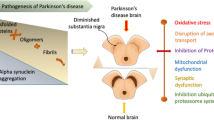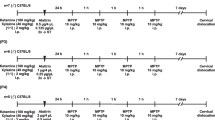Abstract
In the clinical treatment of Parkinson’s disease (PD), the emergence of l-DOPA-induced dyskinesia (LID) and other motor symptoms remains a restrictive factor for the use of levodopa (l-DOPA). Our objective was to test the effect of continuous dopaminergic stimulation (CDS) on LID and the mechanism of its effect on the calcium (Ca2+) signaling pathway. 6-OHDA (6-hydroxydopamine)-treated rats were administered 1% CMC-Na, l-DOPA, rotigotine behenate (RGTB), and l-DOPA + RGTB, respectively, for 28 days. During the treatment, the abnormal involuntary movement (AIM) scores were conducted on days 1, 5, 10, 14, 19, 23 and 28 after the first dose. Subsequently, the number of tyrosine hydroxylase (TH)-positive neurons was detected by immunohistochemistry. Additionally, the changes in Ca2+ were detected using a laser confocal technique, and the related proteins, such as neuronal NOS (nNOS), BAX, BCl2, CaMKII, P-CaMKII, and PSD-95, were measured by Western blot. Transmission electron microscopy (TEM) was used to investigate the changes in synaptic structure. The data showed that CDS reduced the AIM scores, increased the expression of TH in the substantia nigra (SN), decreased the expression of nNOS and BAX/BCL2ratio in the striatum, reduced the Ca2+ influx induced by l-DOPA and inhibited the Ca2+ signaling pathways of dopamine neurons in the striatum. Moreover, the overactivity of synapses induced by L-DOPA was inhibited by CDS. These data further support the hypothesis that continuous delivery of a dopamine agonist reduces the risk of LID induction. Moreover, RGTB could be a promising treatment for PD by simulating CDS.






Similar content being viewed by others
References
Ba M, Ding W, Guan L, Lv Y, Kong M (2019) S-Nitrosylation of Src by NR2B-nNOS signal causes Src activation and NR2B tyrosine phosphorylation in levodopa-induced dyskinetic rat model. Hum Exp Toxicol 38:303–310. https://doi.org/10.1177/0960327118806633
Blandini F, Armentero M-T, Martignoni E (2008) The 6-hydroxydopamine model: news from the past. Parkinsonism Relat Disord 14:S124–S129
Blandini F, Bazzini E, Marino F, Saporiti F, Armentero MT, Pacchetti C, Zangaglia R, Martignoni E, Lecchini S, Nappi G, Cosentino M (2009) Calcium homeostasis is dysregulated in parkinsonian patients with l-DOPA-induced dyskinesias. Clin Neuropharmacol 32:133–139. https://doi.org/10.1097/WNF.0B013E3181761466
Bogucki A, Sławek J (2010) Ciągła stymulacja dopaminergiczna—doświadczenia kliniczne. Neurol Neurochir Pol 44:385–395. https://doi.org/10.1016/s0028-3843(14)60298-x
Breger LS, Dunnett SB, Lane EL (2013) Comparison of rating scales used to evaluate l-DOPA-induced dyskinesia in the 6-OHDA lesioned rat. Neurobiol Dis 50:142–150
Brotchie J, Jenner P (2011) New approaches to therapy. Int Rev Neurobiol 98:123–150. https://doi.org/10.1016/B978-0-12-381328-2.00005-5
Buchwalow IB, Böcker W (2010) Background staining, autofluorescence and blocking steps. Immunohistochemistry: Basics and methods. Springer, Berlin, Heidelberg. https://doi.org/10.1007/978-3-642-04609-4_5
Cenci MA, Riggare S, Pahwa R, Eidelberg D, Hauser RA (2020) Dyskinesia matters. Mov Disord 35:392–396. https://doi.org/10.1002/mds.27959
Gallagher S, Winston SE, Fuller SA, Hurrell JG (2011) Immunoblotting and immunodetection. Curr Protoc Cell Biol 52:6.2.1-6.2.28
Gottwald MD, Aminoff MJ (2011) Therapies for dopaminergic-induced dyskinesias in Parkinson disease. Ann Neurol 69:919–927. https://doi.org/10.1002/ana.22423
Horowski R, Marsden CD, Obeso JA (1988) Continuous dopaminergic stimulation: state of the art and outlook. J Neural Transm Suppl 27:249–252. https://doi.org/10.1007/978-3-7091-8954-2_21
Jenner P (2004) Avoidance of dyskinesia: preclinical evidence for continuous dopaminergic stimulation. Neurology 62:S47–S55. https://doi.org/10.1212/wnl.62.1_suppl_1.s47
Junior NCF, Dos-Santos-Pereira M, Guimaraes FS, Del Bel E (2020) Cannabidiol and cannabinoid compounds as potential strategies for treating Parkinson’s Disease and l-DOPA-induced dyskinesia. Neurotox Res 37:12–29. https://doi.org/10.1007/s12640-019-00109-8
Keifman E, Ruiz-DeDiego I, Pafundo DE, Paz RM, Solis O, Murer MG, Moratalla R (2019) Optostimulation of striatonigral terminals in substantia nigra induces dyskinesia that increases after l-DOPA in a mouse model of Parkinson’s disease. Br J Pharmacol 176:2146–2161. https://doi.org/10.1111/bph.14663
Kobylecki C, Crossman AR, Ravenscroft P (2013) Alternative splicing of AMPA receptor subunits in the 6-OHDA-lesioned rat model of Parkinson’s disease and l-DOPA-induced dyskinesia. Exp Neurol 247:476–484. https://doi.org/10.1016/j.expneurol.2013.01.019
Muller T, Mohr JD (2019) Recent clinical advances in pharmacotherapy for levodopa-induced dyskinesia. Drugs 79:1367–1374. https://doi.org/10.1007/s40265-019-01170-5
Olanow CW, Obeso JA, Stocchi F (2006) Drug insight: continuous dopaminergic stimulation in the treatment of Parkinson’s disease. Nat Clin Pract Neurol 2:382–392. https://doi.org/10.1038/ncpneuro0222
Olanow CW, Calabresi P, Obeso JA (2020) Continuous dopaminergic stimulation as a treatment for Parkinson’s disease: current status and future opportunities. Mov Disord 35:1731–1744. https://doi.org/10.1002/mds.28215
Picconi B, Pisani A, Barone I, Bonsi P, Centonze D, Bernardi G, Calabresi P (2005) Pathological synaptic plasticity in the striatum: implications for Parkinson’s disease. Neurotoxicology 26:779–783
Rodriguez-Oroz MC, Marin C, de Fabregues O (2011) Continuous dopaminergic stimulation: clinical aspects and experimental bases. Neurologist 17:S30–S37. https://doi.org/10.1097/NRL.0b013e31823966e3
Sha C, Han J, Zhao F, Shao X, Yang H, Wang L, Yu F, Liu W, Li Y (2017) Validated LC-MS/MS method for the simultaneous determination of rotigotine and its prodrug in rat plasma and an application to pharmacokinetics and biological conversion in vitro. J Pharm Biomed Anal 146:24–28. https://doi.org/10.1016/j.jpba.2017.07.018
Stocchi F (2011) Continuous dopaminergic stimulation and novel formulations of dopamine agonists. J Neurol 258:S316–S322. https://doi.org/10.1007/s00415-011-6024-y
van Wamelen DJ, Grigoriou S, Chaudhuri KR, Odin P (2018) Continuous drug delivery aiming continuous dopaminergic stimulation in Parkinson’s disease. J Parkinsons Dis 8:S65–S72. https://doi.org/10.3233/JPD-181476
Wang XS, Zhang ZR, Zhang XR, Chen SY, Shao B, Xie CL (2018) Modulation of CaMKIIa-GluN2B interaction in levodopa-induced dyskinesia in 6-OHDA-lesioned Parkinson’s rats. Biomed Pharmacother 107:769–776. https://doi.org/10.1016/j.biopha.2018.08.062
Winey M, Meehl JB, O’Toole ET, Giddings TH Jr (2014) Conventional transmission electron microscopy. Mol Biol Cell 25:319–323
Yang X, Zhu Z, Ding X, Wang X, Cui G, Hua F, Xiang J (2018) CaMKII inhibition ameliorated levodopa-induced dyskinesia by downregulating tyrosine hydroxylase activity in an experimental model of Parkinson’s disease. Brain Res 1687:66–73. https://doi.org/10.1016/j.brainres.2018.02.013
Yu SJ, Chen S, Yang YY, Glotfelty EJ, Jung J, Kim HK, Choi HI, Choi DS, Hoffer BJ, Greig NH, Wang Y (2020) PT320, sustained-release exendin-4, mitigates L-DOPA-induced dyskinesia in a rat 6-hydroxydopamine model of Parkinson’s disease. Front Neurosci 14:785. https://doi.org/10.3389/fnins.2020.00785
Acknowledgements
This project was supported by Yantai University and we thank all authors’ contribution to this manuscript.
Funding
This project was supported by Yantai University. The author(s) disclose receipt of the following financial support for the research, authorship, and/or publication of this article: this work was supported by the “Taishan Industry Leading Talent Laureate”.
Author information
Authors and Affiliations
Contributions
JF and XZ performed the research, analyzed the data, and wrote the manuscript. FT contributed to animal experiments. XY designed and funded the research, and finally approved the submission of this manuscript.
Corresponding author
Ethics declarations
Conflicts of interest
The authors declare that they have no known competing financial interests or personal relationships that could have appeared to influence the work reported in this paper.
Ethical approval
This study was obtained from the Care and Use of Experimental Animal Research Committee at Yantai University (approval number: YT-YX-2019–0097).
Additional information
Communicated by Sreedharan Sajikumar.
Publisher's Note
Springer Nature remains neutral with regard to jurisdictional claims in published maps and institutional affiliations.
Supplementary Information
Below is the link to the electronic supplementary material.
Rights and permissions
About this article
Cite this article
Fu, J., Zhao, X., Tian, F. et al. Continuous dopaminergic stimulation counteracts l-DOPA-induced overactivity of Ca2+ in 6-OHDA-lesioned rats. Exp Brain Res 240, 1933–1941 (2022). https://doi.org/10.1007/s00221-022-06390-y
Received:
Accepted:
Published:
Issue Date:
DOI: https://doi.org/10.1007/s00221-022-06390-y




